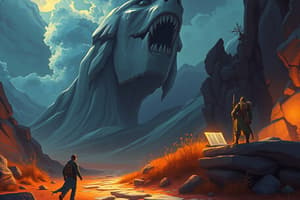Podcast
Questions and Answers
What is a story often considered?
What is a story often considered?
A work of art or narrative discourse
Name two types of literature that stories can take the form of.
Name two types of literature that stories can take the form of.
Novels, short stories
What mediums can stories be found across?
What mediums can stories be found across?
Film, television shows, video games
What is the primary method of storytelling before written texts became common?
What is the primary method of storytelling before written texts became common?
What are the key elements of a good story structure?
What are the key elements of a good story structure?
How have written narratives impacted the preservation of stories?
How have written narratives impacted the preservation of stories?
What are some purposes of storytelling throughout history?
What are some purposes of storytelling throughout history?
Name a nonfictional genre where stories can be found.
Name a nonfictional genre where stories can be found.
What role does symbolism play in many successful stories?
What role does symbolism play in many successful stories?
What helps build suspense and tension in a good story?
What helps build suspense and tension in a good story?
Flashcards are hidden until you start studying
Study Notes
A story is often considered a work of art or narrative discourse that presents events, real or imagined, through the experiences and actions of one or more characters. It can take many forms, including various types of literature such as novels, short stories, poems, plays, fables, myths, legends, epics, and ballads, as well as nonfictional genres like biographies, memoirs, histories, scientific reports, folklore, and fairy tales. Stories can also be found across different mediums like film, television shows, video games, music albums, podcasts, comics, graphic novels, and even interactive performances.
Storytelling has been used throughout human history to convey information, entertain others, teach moral lessons, and create shared cultural memories. Oral storytelling was the primary method before written texts became commonplace, with listeners engaging with the plot using their imagination based on verbal description alone. Written narratives have allowed for stories to be preserved over time, influencing later generations who may never meet the teller personally.
The structure of a good story typically includes an introduction, rising action, climax, falling action, and resolution. This format helps build suspense and tension while satisfying audiences' expectations for narrative clarity. Many successful stories incorporate elements such as drama, character development, setting details, symbolism, irony, humor, and themes. These aspects contribute to crafting memorable plots and making them deeply moving or thought-provoking.
While personal preferences will always influence what someone considers 'a great story,' there are certain characteristics commonly associated with quality tales. For instance, believable characters whose motivations drive the plot forward; vivid settings where action takes place; consistent tone which supports the main theme; well-paced narrative integral to audience engagement; authentic dialogue reflective of each personality. Therefore, a compelling tale should evoke strong emotions from its readers/listeners, stimulate critical thinking, alter perceptions, inspire change in behavior, enhance creativity, broaden understanding, foster empathy towards others, etc..
Studying That Suits You
Use AI to generate personalized quizzes and flashcards to suit your learning preferences.



